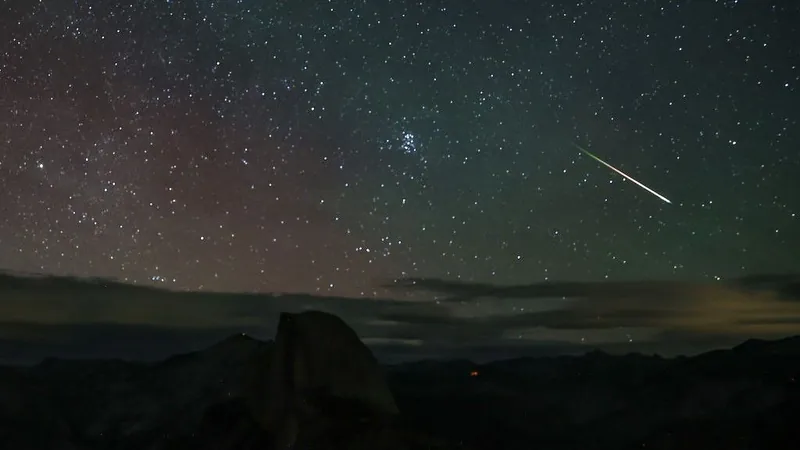
Shocking New Study Reveals the Truth Behind 2014's 'Interstellar' Fireballs!
2024-11-01
Author: Wei Ling
Study Overview
In a groundbreaking revelation, researchers have determined that the much-talked-about fireball recorded over the Pacific Ocean in 2014 did not originate from the depths of interstellar space as previously believed. Instead, new modeling suggests it more likely came from within our own solar system. This revelation raises questions about the nature of debris recovered from the event, which experts now suggest has a more mundane origin.
Research Team and Methods
The study, conducted by an international team of astronomers led by Maria Hajduková of the Slovak Academy of Sciences, delves into the data from NASA's Center for Near Earth Object Studies (CNEOS). By analyzing the fireball's altitude and velocity measurements, researchers uncovered significant errors in the recorded data that could lead to misinterpretation. Hajduková's findings suggest that without understanding these error ranges, meteors that are actually our solar system's native debris could easily be misidentified as interstellar objects.
Understanding Fireballs
Fireballs are the most spectacular form of falling meteors, appearing as brilliant streaks of light across the sky. While many commonly seen meteors are merely tiny dust particles, fireballs can result from larger stone-sized meteoroids. These meteorites often disintegrate upon entering Earth's atmosphere, bolstering the argument that any claims of remnants from so-called interstellar fireballs need careful reevaluation.
Contrasting Claims by Other Astronomers
The study comes in stark contrast to claims made by Harvard astronomer Avi Loeb and his colleague Amir Siraj, who are no strangers to sensational assertions regarding space phenomena. Loeb and Siraj believed that the fireball in question, which was detected by U.S. defense sensors on January 8, 2014, represented an object hailing from beyond our solar system. In their pursuit of truth, they even initiated a cryptocurrency-funded expedition to scout the ocean floor for remnants, claiming they discovered "spherules" with distinct interstellar properties. However, independent analyses have countered this assertion by determining their composition is more consistent with industrial waste.
Key Findings of the New Study
Adding fuel to the discussion, Hajduková’s team quantitatively demonstrated that the 2014 fireball was highly unlikely to be interstellar. This is largely because while Loeb and Siraj based their argument on the fireball's impressive speed—27.8 miles (44.8 kilometers) per second—this velocity does not necessarily mean it came from outside the solar system. The team emphasized that until the error ranges are fully understood, classifying any fireball as interstellar is highly speculative.
Implications for Future Research
While previous studies suggested there could be up to 10,000 interstellar objects zooming through our solar system at any moment, Hajduková's team concluded that actual occurrences of these interstellar fireballs would be exceedingly rare. Their findings indicate that the current data set of fireballs could produce false positives for interstellar origins due to measurement errors, with a staggering 93% chance that at least one recorded event could be misclassified.
Conclusion
In light of these revelations, the implications extend far beyond just the 2014 incident. If significant overestimations in velocity are commonplace, it compels scientists to reevaluate prior claims of origins for numerous meteoritic events. The research highlights how critical precise measurements are for understanding the solar system’s history and the populations of small celestial bodies that traverse near Earth.
As the discussion unfolds, scientists and enthusiasts alike will undoubtedly keep a close eye on future studies that delve into the enigmatic nature of fireballs and their origins in our cosmic neighborhood. Stay tuned, as this saga around interstellar claims and debris recovery continues to unfold!





 Brasil (PT)
Brasil (PT)
 Canada (EN)
Canada (EN)
 Chile (ES)
Chile (ES)
 España (ES)
España (ES)
 France (FR)
France (FR)
 Hong Kong (EN)
Hong Kong (EN)
 Italia (IT)
Italia (IT)
 日本 (JA)
日本 (JA)
 Magyarország (HU)
Magyarország (HU)
 Norge (NO)
Norge (NO)
 Polska (PL)
Polska (PL)
 Schweiz (DE)
Schweiz (DE)
 Singapore (EN)
Singapore (EN)
 Sverige (SV)
Sverige (SV)
 Suomi (FI)
Suomi (FI)
 Türkiye (TR)
Türkiye (TR)